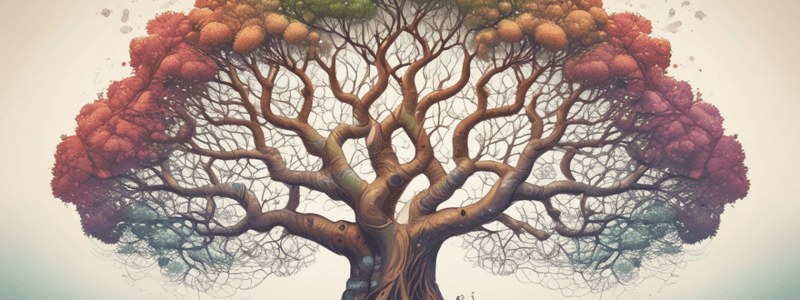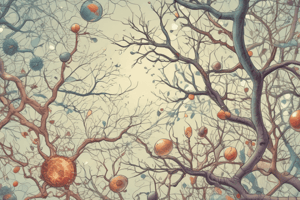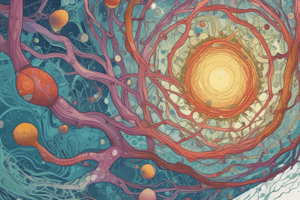Podcast
Questions and Answers
What is the study of the interactions between organisms and their environment called?
What is the study of the interactions between organisms and their environment called?
- Microbiology
- Genetics
- Ecology (correct)
- Biochemistry
What is the process by which cells convert light energy into chemical energy?
What is the process by which cells convert light energy into chemical energy?
- Respiration
- Meiosis
- Photosynthesis (correct)
- Mitosis
What is the term for the survival and reproduction of the fittest individuals in a population? dhdndh
What is the term for the survival and reproduction of the fittest individuals in a population? dhdndh
- Gene flow (correct)
- Natural selection
- Mutation
- Genetic drift
What is the structure that contains DNA and controls cell growth and reproduction?
What is the structure that contains DNA and controls cell growth and reproduction?
What is the process by which DNA is converted into RNA?
What is the process by which DNA is converted into RNA?
What is the term for the movement of genes between populations?
What is the term for the movement of genes between populations?
Study Notes
Branches of Biology
- Botany: study of plants
- Zoology: study of animals
- Microbiology: study of microorganisms (bacteria, viruses, etc.)
- Ecology: study of interactions between organisms and their environment
- Biochemistry: study of chemical processes in living organisms
- Molecular Biology: study of biological molecules and their interactions
- Genetics: study of heredity and variation
- Evolutionary Biology: study of evolution and diversity of life
Cell Biology
- Cell structure:
- Plasma membrane: outer layer, regulates what enters and leaves cell
- Cytoplasm: jelly-like substance inside cell, contains organelles
- Nucleus: contains DNA, controls cell growth and reproduction
- Cellular processes:
- Photosynthesis: conversion of light energy into chemical energy
- Respiration: conversion of chemical energy into ATP
- Mitosis: cell division, resulting in two identical daughter cells
- Meiosis: cell division, resulting in four non-identical daughter cells (gametes)
Genetics
- Mendel's Laws:
- Law of Segregation: alleles separate during gamete formation
- Law of Independent Assortment: alleles for different genes are sorted independently
- Law of Dominance: dominant allele is expressed over recessive allele
- DNA structure:
- Double helix: two strands of nucleotides twisted together
- Nucleotides: composed of sugar, phosphate, and nitrogenous base
- Genetic code: sequence of nucleotides determines amino acid sequence
- Gene expression:
- Transcription: DNA to RNA
- Translation: RNA to protein
Evolution
- Mechanisms of evolution:
- Natural selection: survival and reproduction of fittest individuals
- Genetic drift: random change in allele frequency
- Mutation: change in DNA sequence
- Gene flow: movement of genes between populations
- Evidence for evolution:
- Fossil record: chronological record of life on Earth
- Comparative anatomy: similar structures in different species
- Molecular biology: similarities in DNA and protein sequences
Ecosystems
- Components of ecosystems:
- Biotic factors: living organisms (plants, animals, microorganisms)
- Abiotic factors: non-living components (light, temperature, water, etc.)
- Energy flow:
- Producers: convert sunlight into energy (plants, algae)
- Consumers: obtain energy by consuming other organisms
- Decomposers: break down organic matter
- Nutrient cycles:
- Carbon cycle: exchange of carbon between organisms and environment
- Nitrogen cycle: exchange of nitrogen between organisms and environment
- Water cycle: exchange of water between organisms and environment
Branches of Biology
- Botany is the study of plants
- Zoology is the study of animals
- Microbiology is the study of microorganisms, including bacteria and viruses
- Ecology is the study of interactions between organisms and their environment
- Biochemistry is the study of chemical processes in living organisms
- Molecular Biology is the study of biological molecules and their interactions
- Genetics is the study of heredity and variation
- Evolutionary Biology is the study of evolution and diversity of life
Cell Biology
- Plasma membrane is the outer layer of a cell, regulating what enters and leaves
- Cytoplasm is a jelly-like substance inside a cell, containing organelles
- Nucleus contains DNA, controlling cell growth and reproduction
- Photosynthesis is the conversion of light energy into chemical energy
- Respiration is the conversion of chemical energy into ATP
- Mitosis is cell division, resulting in two identical daughter cells
- Meiosis is cell division, resulting in four non-identical daughter cells (gametes)
Genetics
- Mendel's Law of Segregation states that alleles separate during gamete formation
- Mendel's Law of Independent Assortment states that alleles for different genes are sorted independently
- Mendel's Law of Dominance states that dominant alleles are expressed over recessive alleles
- DNA structure is a double helix, consisting of two strands of nucleotides twisted together
- Nucleotides are composed of sugar, phosphate, and nitrogenous base
- The genetic code determines amino acid sequence based on nucleotide sequence
- Transcription is the process of DNA to RNA
- Translation is the process of RNA to protein
Evolution
- Mechanisms of evolution include natural selection, genetic drift, mutation, and gene flow
- Natural selection is the survival and reproduction of fittest individuals
- Genetic drift is a random change in allele frequency
- Mutation is a change in DNA sequence
- Gene flow is the movement of genes between populations
- Fossil record provides a chronological record of life on Earth
- Comparative anatomy shows similar structures in different species
- Molecular biology reveals similarities in DNA and protein sequences between species
Ecosystems
- Biotic factors are living organisms, including plants, animals, and microorganisms
- Abiotic factors are non-living components, including light, temperature, water, and more
- Producers convert sunlight into energy, including plants and algae
- Consumers obtain energy by consuming other organisms
- Decomposers break down organic matter
- Energy flow occurs from producers to consumers and decomposers
- Carbon cycle is the exchange of carbon between organisms and environment
- Nitrogen cycle is the exchange of nitrogen between organisms and environment
- Water cycle is the exchange of water between organisms and environment
Studying That Suits You
Use AI to generate personalized quizzes and flashcards to suit your learning preferences.
Description
Learn about the different branches of biology, including botany, zoology, and microbiology, as well as the basics of cell biology. Understand the scope of each field and its significance in understanding living organisms.




